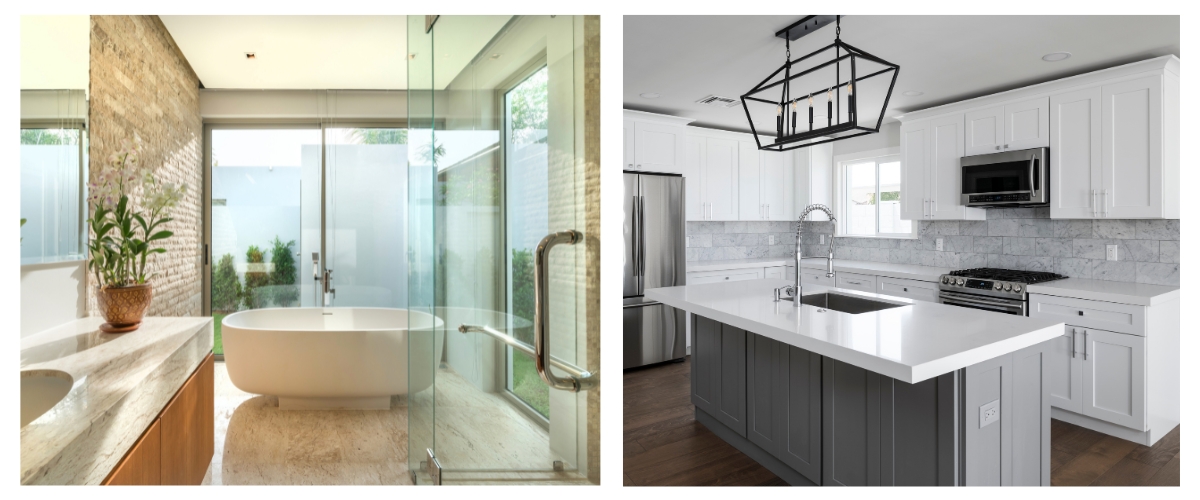When it comes to enhancing your living space, the terms “remodel” and “renovation” are often used interchangeably, but they entail different scopes and objectives. Deciding between a remodel and a renovation requires a comprehensive understanding of the changes you want to make and the goals you aim to achieve. Let’s delve into the dissimilarities between the two and help you determine which approach aligns better with your needs.
Remodeling: Transforming Spaces with Purpose
Home remodeling goes beyond surface-level changes, focusing on completely transforming the structure or layout. When you opt for a remodel, you’re essentially reimagining the space, often involving structural alterations. This comprehensive approach allows for significant design, functionality, and overall aesthetics changes.
Key Features of Remodeling:
- Structural Modifications: Remodeling often includes structural changes, such as removing walls to create an open floor plan or adding extensions for extra space.
- Functional Upgrades: The primary goal of remodeling is to enhance functionality. This may involve upgrading appliances, installing modern fixtures, or reconfiguring the layout for better usability.
- Aesthetic Overhaul: Remodels typically focus on aesthetic improvements, incorporating contemporary design elements to give your space a fresh and modern look.

Renovation: Refreshing the Existing
Renovation is more about restoring or revitalizing the existing structure without significantly altering its form or layout. Renovations are often considered a more budget-friendly option, ideal for those who want to enhance the appearance and functionality of their space without undertaking a complete overhaul.
Key Features of Renovation:
- Surface-Level Changes: Unlike remodeling, renovations involve surface-level modifications, such as repainting, flooring replacements, or updating fixtures.
- Preservation of Structure: Renovations aim to preserve the existing structure while making improvements. This is an excellent option for maintaining the character of older homes.
- Cost-Effective Solutions: Renovations are generally more cost-effective than remodeling, making them a practical choice for homeowners on a budget.
Choosing Between Remodeling and Renovation: Factors to Consider
When deciding between remodeling and renovation, several factors come into play. Consider the following aspects to determine which approach aligns with your goals and constraints:
- Scope of Changes: Assess the extent of changes you envision for your space. Remodeling may be the way to go if a complete transformation is desired.
- Budget Considerations: Determine your budget constraints. Renovations are often more budget-friendly, making them suitable for cost-conscious homeowners.
- Timeline: Consider the timeframe for your project. Remodels may take longer due to extensive structural changes, while renovations are generally quicker.
- Structural Integrity: If your home requires structural updates, a remodel may be necessary to address these issues comprehensively.

Choosing the Right Path
- Assessing Your Goals: Before embarking on any home improvement journey, outline your objectives. If you desire a fresh, modern look and are open to structural changes, remodeling might be the answer. However, if you’re content with your home’s layout and wish to enhance its appearance and functionality, renovation could be the more suitable choice.
- Consulting Professionals: Seeking guidance from architects or contractors is essential. They can evaluate your space, discuss your goals, and provide insights into the feasibility and cost implications of remodeling versus renovating.
Navigating the Decision-Making Process
In conclusion, the decision between remodeling and renovation ultimately depends on your needs, budget, and preferences. Whether you’re looking to create a modern, open living space through remodeling or seeking to refresh the charm of your existing home with a renovation, understanding the differences empowers you to make an informed choice. Remember, aligning your home improvement goals with the approach that best suits your vision and resources is critical.

